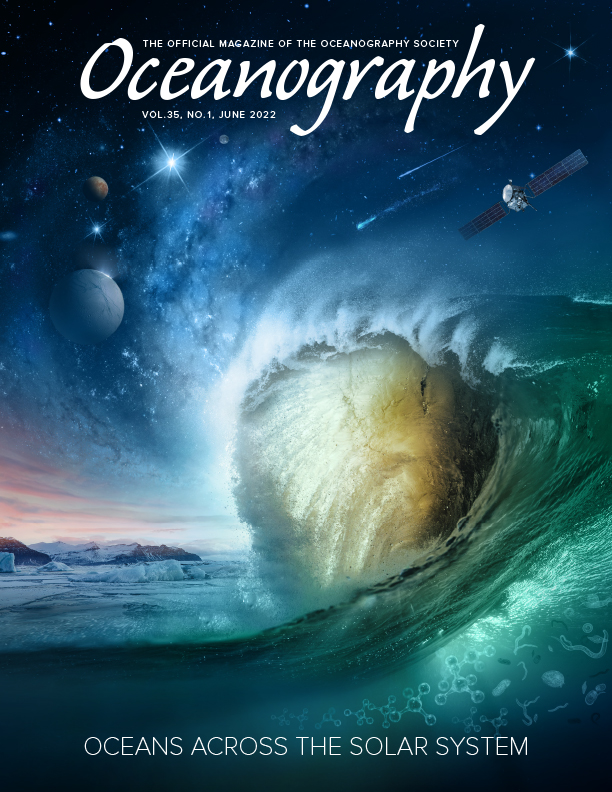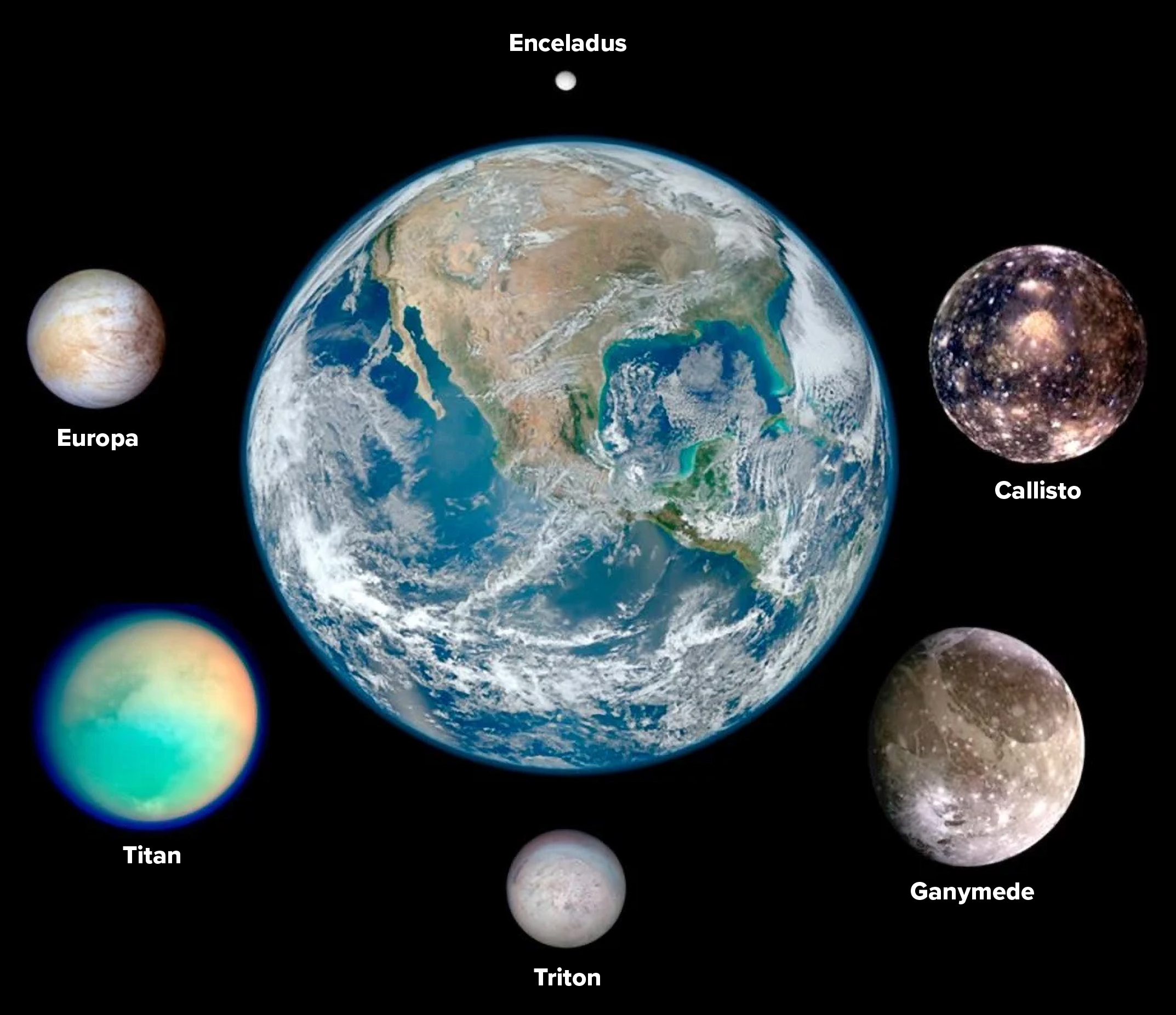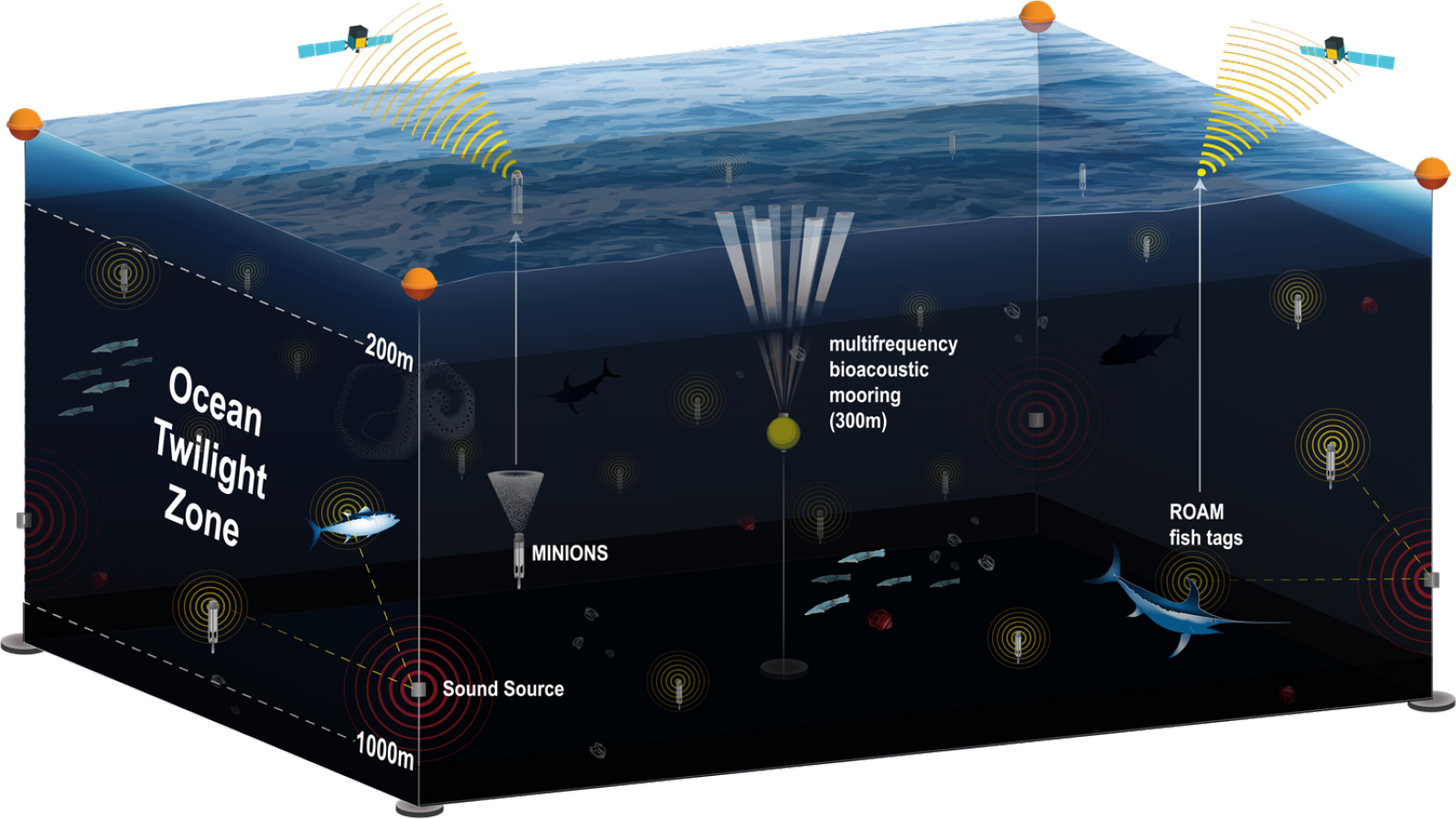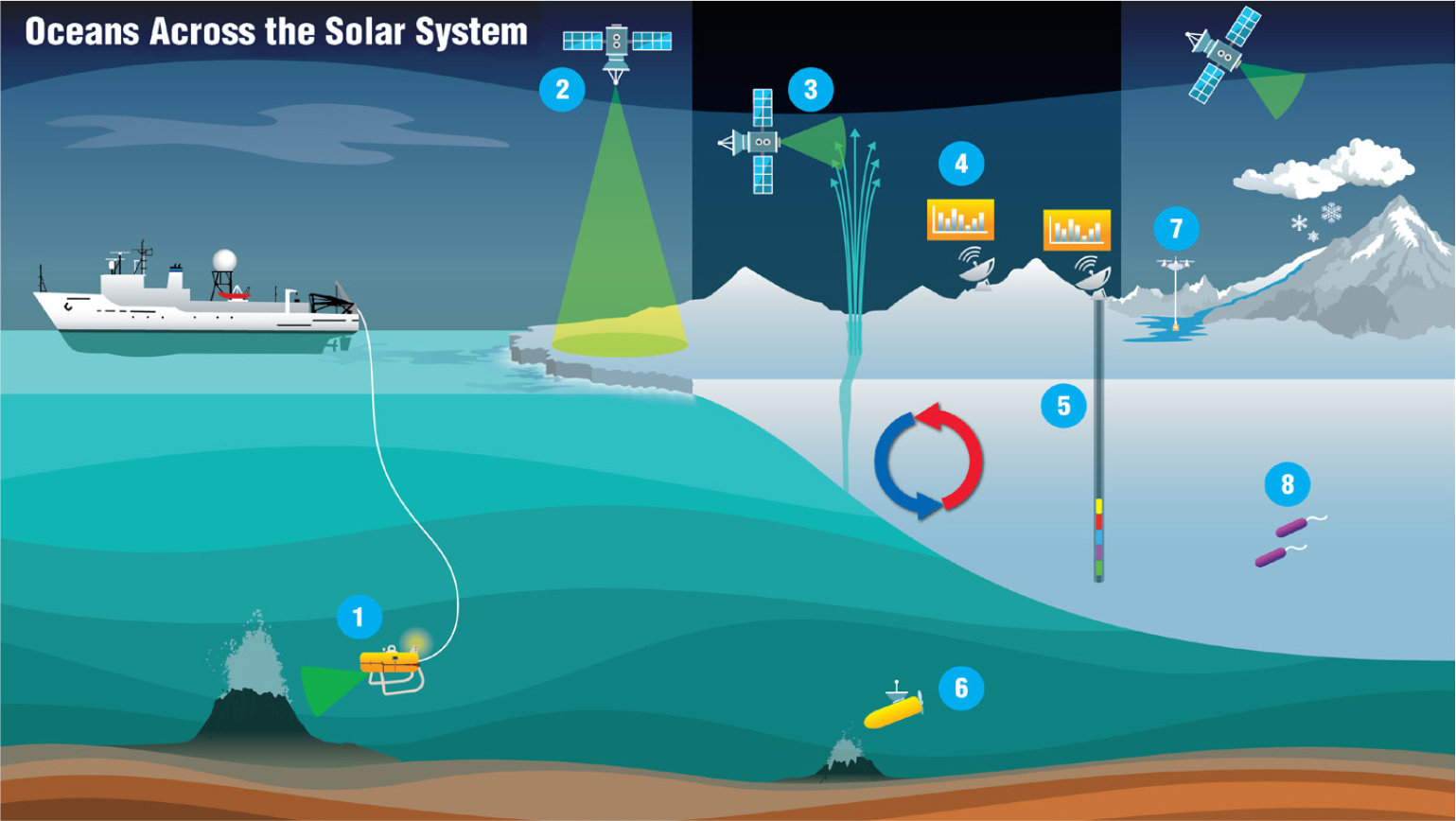Full Text
Introduction
The study of planetary oceanography is a new and exciting field of research. While humanity’s formal scientific studies of Earth’s ocean began nearly 150 years ago with the launch of the Challenger Expedition (Thomson et al., 1873), the study of oceans beyond Earth commenced only in this millennium. The first confirmation of an extensive saltwater ocean anywhere beyond Earth came relatively late within the lifetime of NASA’s Galileo mission (1989–2003; Kivelson et al., 2000), but continuing exploration has now revealed compelling evidence for large-volume watery oceans on five ice-covered moons of our outer solar system (Figure 1), with as many as 10–20 candidate moons and dwarf planets also under consideration (Hendrix et al., 2019). Of the five confirmed ocean worlds (Jupiter’s moons Europa, Callisto, and Ganymede; Saturn’s moons Enceladus and Titan), three have oceans so deep that a high-pressure form of ice develops deep within the ocean, beneath the liquid water but overlying any rocky interior (Nimmo and Papallardo, 2016). As a consequence, the watery ocean is trapped within an “ice sandwich.” By contrast, the other two confirmed ocean worlds (Europa and Enceladus) have oceans that are in direct contact with a rocky interior.
|
|
While the discovery that there are major oceans beyond Earth within our own solar system is already scientifically exciting for oceanographers and planetary scientists, the discovery that Europa and Enceladus have ocean worlds in contact with rocky seafloors presents a new opportunity to launch a meaningful search for life beyond Earth, a venture that could have profound societal impact. It was only during the latter part of the last century that hot springs were first discovered on the seafloor near the Galápagos Rift in the eastern Pacific Ocean (Corliss et al., 1979). There, geothermal energy from Earth’s interior drives subseafloor fluid convection that gives rise to the release of highly reduced compounds that are rich in chemical energy at and near the seabed. This chemical energy is utilized by a suite of bacteria and archaea that can chemosynthetically fix carbon that, in turn, can sustain lush, oasis-like ecosystems populated by species previously unknown to science. In the intervening decades, hundreds of new species of micro- to mega-fauna have been discovered on the deep, dark seafloor at an increasing number of vent sites. While the majority of Earth’s deep ocean remains unexplored in detail, we can at least confirm that venting occurs in every ocean basin on our planet (Beaulieu et al., 2013).
Importantly, however, the physiology of vent-endemic multicelled organisms has revealed a dependency on a relatively oxygenated ocean and, hence, should not be considered independent of sunlight. It requires both photosynthesis to introduce oxygen into the upper layers of the ocean and overturning circulation to bring that oxygenated water to depth (Van Dover et al., 2002; Tyler et al., 2002). For the microbial populations that form the base of the chemosynthetic food chain, however, oxygenated waters are not a requirement. Guided, in part, by predictive studies to inform future space missions (Shock and Schulte, 1998), our continuing exploration of Earth has revealed an ever-expanding diversity of geologic settings where seafloor fluid flow can arise (German and Seyfried, 2014; German et al., 2016), including the first definitive evidence for conditions under which abiotic organic synthesis of key prebiotic molecules can arise (McDermott et al., 2015).
Thus, it is entirely plausible that ocean worlds such as Europa and Enceladus in the outer solar system could harbor and sustain life, despite being distant from the sun that powers photosynthetic life on Earth and fuels Earth’s rich biosphere. Instead, just as in Earth’s deep and dark oceans, water-rock interactions might give rise to chemical energy that can fuel requisite metabolisms for primitive forms of microbial life. Of course, on other moons, there is no requirement that chemical energy release be focused at the seafloor. Life on Earth also thrives at Earth’s ocean-ice interface, albeit fueled by the sun (Arrigo et al., 2012). In the case of Europa, where oxygen is generated at the outer surface of the continuously recycled ice shell, predictions by Russell et al. (2017) suggest the potential for redox exchange at the ice-ocean interface. We can anticipate that ocean worlds are habitable and, potentially, inhabited. How, then, should we explore them?
Shared Interdisciplinary Values
In the study of Earth processes, whether in ocean or polar research, it is well recognized that judicious use of theoretical modeling and laboratory experiments can provide invaluable predictive capabilities, comparatively inexpensively, prior to launching field campaigns. This is important because, while field campaigns can realize the inestimable rewards of direct observations, they also provide a unique set of challenges. These can include: accessing specific locations (e.g., deep sea, subsurface seafloor, deep cryosphere, or sea-ice encumbered oceans), developing the advanced technology required to collect samples and make remote observations in extreme environments, and securing the resources required to conduct those expeditions. For space-based research, whether for Earth observations via remote sensing or for planetary exploration, the challenges are similar. Experience shows that to progress from the conception of comprehensive oceanographic, polar, and space-based missions to their implementation in the field can span timescales of years to decades—but that the rewards can be paradigm shifting.
In the study of ocean worlds beyond Earth, therefore, it seems obvious that benefits should accrue if the planetary science community seeks to take advantage of the >150 year head start that oceanographers have in the study of oceanographic processes on Earth and the corresponding ~100 year head start in the study of Earth’s cryosphere. Simultaneously, combinations of the data obtained from other ocean worlds and the theoretical modeling used to predict their characteristics can provide ocean and cryosphere scientists with fresh perspectives for exploring Earth. As one example, a theoretical study of other planets (Shock and Schulte, 1998) prompted NASA-funded exploration of the Mid-Cayman Rise that yielded the discovery of abiotic organic synthesis on Earth’s deep seafloor (McDermott et al., 2015).
While our two scientific communities, until very recently, have remained mostly insulated from one another, there are good cultural grounds upon which to build future collaboration. Each field—of necessity—has already evolved to be both multidisciplinary and interdisciplinary in nature; physical, chemical, and geological processes are already known to interact with one another on other planetary bodies, with multiple feedback loops. The same is true on Earth, where there is also an increasing consciousness of the role that life plays in interacting with and even regulating many geological and geochemical systems. In fact, this realization has given rise to a whole new field of study—geobiology. Might the same be true in space? Soberingly, life may well be present, awaiting discovery, on planetary bodies that Earth-launched spacecraft have already passed by.
A Plan for Action
Below, we lay out the basis for developing a new cross-disciplinary research theme focused on the study of ocean worlds, one that harnesses community-level engagement across the Earth and planetary sciences and works toward the pooling of resources and expertise across those diverse communities. We close by identifying key next steps toward implementing such a vision.
Vision for a Collaborative Future
Both the study of planetary sciences and the study of Earth’s ocean and cryosphere are comprised of inherently interdisciplinary science and scientists. There are multiple areas of expertise within the Earth, ocean, and cryosphere communities, extending spatially from subseafloor geology in the deepest ocean up through the oceanic water column and to ocean-ice interactions, where expertise relevant to the study of ocean worlds most certainly exists. There are also other aspects of the ocean and the cryosphere on Earth that may not map so directly to ocean worlds. As one translational illustration, the external temperatures of the cryospheres of Europa and Enceladus may be about 100°C colder than at Earth’s icecaps. However, while that significant offset may appear to close a simple route for comparative studies among ocean world cryospheres, it may actually open up several more. Ice in the outer shell of Europa or Enceladus may not exhibit identical properties to ice at the exterior of Earth’s cryosphere, but thinking laterally, the study of rock mechanics on Earth can inform the mechanics of brittle-ice behavior at the exterior of an ocean world. Further, the study of cryosphere processes across the temperature ranges that are found on Earth can inform the predicted behavior of deeper, warmer ice on any ocean world as it approaches the temperatures to be expected, close to 273K, at any ice-ocean interface regardless of ocean salinity or ice-shell thickness.
This simple example reveals a wider truth—there is untapped potential that could be released by bringing together disciplinarily diverse research communities to share questions, outline their objectives, and provide a broader platform where previously unrecognized opportunities for collaboration can be identified and stimulated. Research communities are stronger when they pool individual resources and talent from across disciplines. Shared expertise can be brought to bear on mutual complementary interests, with or without the same specific research goals. Areas of expertise in one field might be of extraordinary value for another team of researchers who had previously been unaware such expertise even existed. Together, new teams of scientists might develop and find ways to test new hypotheses that neither, in isolation, could previously even articulate. Within this crucible of cutting-edge research, a new generation of interdisciplinary scientists, equally conversant in ocean and planetary sciences, can be forged.
Pooling Resources and Expertise
From an ocean/cryosphere perspective, one of the most obvious near-term contributions that research on Earth can provide for the advancement of ocean world studies elsewhere is accessibility. Whatever the complexities in organizing and scheduling field expeditions on Earth, at least the cadence and transit times to the field area are well understood and come at comparatively low cost, both with respect to time and money. This is not the case for extraterrestrial ocean worlds. For example, Europa is the nearest known ocean world to Earth, but when NASA’s next flagship mission, Europa Clipper, launches in 2024 (Howell and Papallardo, 2020) it will face a six-year transit to reach Jupiter. By the time it starts to return data from its survey fly-pasts in 2031, nearly a decade hence, it will have been 30 years since that body was first revealed to host a saltwater ocean in contact with a rocky seafloor (Kivelson et al., 2000). Field access may play an especially important role in terms of the opportunity to find extreme life in settings that have never been explored on Earth but have the potential to exist. While process studies in some diverse extreme environments have been conducted in recent decades, most of Earth’s extreme environments remain completely unvisited and much geo- and biodiversity remains to be revealed. Of course, access to Earth’s ocean and cryosphere offers more than just an opportunity to explore extreme environments. It also provides opportunities to extend approaches by which such investigations can be conducted.
Historically, oceanography has been conducted by teams of individuals mounting ship-based expeditions limited by the endurance of the vessel used, the finite resources that can be loaded aboard ship, and the limited amount of time that can be dedicated to the study. The advent of satellite oceanography and the development of robotics have significantly improved temporal and spatial coverage of ocean observations. The recent successes of the Argo float program for physical oceanography and its expansion into studies of ocean biogeochemistry (BGC-Argo; Biogeochemical-Argo Planning Group, 2016) exemplify the potential for such a technological revolution in the ocean sciences. But this field remains in its infancy, while investment into autonomous robotics is widespread across NASA’s programs for exploration beyond Earth. In the future, we anticipate that development of increasingly autonomous ocean-going robotic platforms, such as ocean gliders, coupled to novel and improved airborne and spaceborne sensors, such as hyperspectral radiometers, radars, and lidars, in a truly integrated fashion will be critical to holistic studies for characterizing and sustaining Earth’s ocean. Such an approach would allow three-dimensional characterization of entire ocean basins, based on transmitting information between deep-ocean platforms and shore-based laboratories and bringing together the technological as well as the scientific expertise of the space, ocean, and cryosphere communities. Figure 2 illustrates a nascent vision of how such timely advances could provide transformative benefits to improve our understanding of the global carbon cycle here on Earth. The same approach is readily translatable, conceptually, to the future exploration of oceans beyond Earth.
|
|
One key technological challenge, however, is that the study of biology and ecology in Earth’s ocean has not changed fundamentally since the Challenger Expedition of the 1870s: the collection of samples for return to the laboratory for analysis remains critical for the identification of species and their abundance. While this field is progressing, for example, with the development of robotic in situ sample collection and analysis platforms (Scholin et al., 2009) and the use of environmental DNA sampling (Yamahara et al., 2019), continuing developments are needed in instrumentation and analysis for different types of biosignatures pertinent to the system being investigated—both here on Earth and on other ocean worlds. See Chirayath et al., (2022, in this issue) and Figure 3 for further discussion on the technologies that will be required for the remote sensing and in situ exploration of ocean worlds.
|
|
For the foreseeable decades, the exploration of ocean worlds will be conducted by robotic missions equipped with in situ sensors. With much longer required communication time from Earth than that for missions to the moon and Mars, ocean world missions will require increased reliance on autonomous platforms and autonomous data analysis, value extraction, and data reduction prior to transmission. All of these technological developments, while essential for the study of ocean worlds beyond Earth, could be transformative for the study of Earth’s ocean and cryosphere. For systems to be approved for space flight, there is a need to advance along a very clear path of technology readiness levels (Banke, 2017). A mission that takes years to reach its destination requires robust technologies that will be effective on arrival. Access to Earth’s ocean and cryosphere provides excellent opportunities to develop and mature such technologies. From the end of a pier to the most corrosive deep ocean vents or the coldest polar terrains, instruments, algorithms, and platforms can all be tested, both individually and as integrated systems. Importantly, because such new space-directed technologies are not routinely available to Earth-based scientists, such testing need not be restricted to engineering trials. Indeed, oceanographers, geochemists, and geobiologists have worked together to instrument the deep sea with observatories (Favali et al., 2015), and even the subseafloor with borehole observatories (Edwards et al., 2012), to capture the changes occurring in these rarely accessed parts of Earth’s ocean. Ocean and cryosphere programs will undoubtedly seize the opportunity to expand autonomous/remote observations and technologies to accelerate exploration and understanding of our own rapidly evolving home planet.
Opportunities also exist for new planetary science-oceanography collaborative approaches to laboratory-based experimentation that can inform theoretical modeling. Laboratory experimentation can provide much needed data for models, allowing them to better simulate extreme and difficult to access locations on Earth and in space. Such facilities could be developed as shared resources, mitigating maintenance and management resources across the communities that enable experiments simulating various extreme environments (varying in scale and time), for example, for subzero, pressure-controlled, or high radiation conditions. Establishing new lines of communication between the planetary and ocean science communities to share current and needed capabilities has the potential to stimulate new science and experimental capabilities that will benefit both fields and foster interdisciplinary collaboration.
With ever-expanding computing power, theoretical forward modeling represents an opportunity to make remote predictions of what might be expected on other ocean worlds. These models can be further improved by collaborations across Earth and planetary scientists, for example, refining models that can capture interface workings—smaller-scale processes not adequately captured in prior Earth or ocean world models—and that can benefit both communities. Similarly, improved predictive modeling can be extremely valuable on Earth to provide simulations that faithfully reproduce observations. Models that can adequately represent the modern-day system can then form the basis for investigating how changes of various parameters, for example, within the bounds of predicted future climate change, might become manifest at the global scale. Traditionally, such modeling has been informed by the cumulative acquisition of decades (in some cases, more than a century) of direct observations from a single ocean system: Earth. Now, the discovery of new planetary-scale oceans has the potential to expand our parameter space. Conceivably, the data sets obtained from other ocean worlds will be so different that they will reveal a need to revisit the conventional wisdom that provides the current foundation for Earth-based modeling. The study of ocean worlds may not just lead to the discovery of life beyond Earth within the next human generation, it could also provide a unique and novel lens through which to reveal what remains to be explored and with what priority, to advance our understanding of our own home planet for the benefit of generations to come.
Priority Next Steps: A New Decade of Opportunity
We anticipate that the coming decade will be transformative in the study of oceans across the solar system. The next Flagship mission to an ocean world, Europa Clipper, is scheduled for launch in 2024 (Howell and Papallardo, 2020), followed by the New Frontiers mission Dragonfly to Titan (Barnes et al., 2021). In its recent publication, Origins, Worlds and Life (NASEM, 2022), the National Academies’ Planetary Science & Astrobiology Decadal Survey made a series of recommendations that would afford exciting further opportunities for ocean worlds investigations. Many of these align closely with ideas proposed by the Network for Ocean Worlds (Howell et al., 2021). In addition to recommendations to increase NASA budgets within the Planetary Science Division (PSD) in the areas of Technology (to 6%–8% of PSD’s annual budget) and Research and Analysis (to 10% of PSD’s annual budget), there are also specific recommendations related to the field of astrobiology that emphasize a future focus on the important areas of systems level thinking, subsurface habitability, and the development of life detection technology (NASEM, 2022). In the decade ahead, there is a specific recommendation that NASA take significant next steps to pursue a meaningful search for life beyond Earth. Along with the recommendation for a Flagship-level study of the Uranus system (which includes multiple candidate ocean worlds similar in size to Enceladus; Simon et al., 2021), the report also recommends a second Flagship-level mission to first orbit and then land on Enceladus, specifically to search for life (MacKenzie et al., 2021). As a clear sign of this commitment to a search for life on ocean worlds, the same report also recommends Enceladus be included in the list of targets for future calls for New Frontiers mission proposals, along with two further ocean worlds—Titan and Triton.
Perhaps most importantly, to achieve all of the above, the Origins, Worlds and Life report makes a particular recommendation that NASA develop an Ocean Worlds Exploration strategy—ideally with new funding opportunities to stimulate partnerships both within NASA (e.g., between the Planetary Science and Earth Science Divisions) and among agencies (NASA, National Science Foundation, and NOAA Ocean Exploration). Of course, any such strategy should also be capable of spanning international boundaries to forge new partnerships and collaborations. To rise to the challenge and meet the aspirational goals outlined above will also require the entrainment of a new generation of ocean and cryosphere scientists to implement novel research programs on Earth. Three critical areas of research might be particularly important in this regard:
- Exploration for relevant ocean world analog sites, which may still await discovery on our own planet, informed by our ever deepening understanding of other ocean worlds (Hand et al., 2020).
- Development of long-term facilities for technology testing, in both deep ocean and cryosphere settings (Ocean Observatories Initiative, 2020; Stone et al., 2021).
- Development of autonomous platforms and sensors for in situ life detection (Chirayath et al., 2022, in this issue).
These goals are challenging, but the opportunities available—to contribute meaningfully to the search for life beyond Earth—are societally profound.




